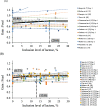Role of milk carbohydrates in intestinal health of nursery pigs: a review
- PMID: 34983676
- PMCID: PMC8729129
- DOI: 10.1186/s40104-021-00650-7
Role of milk carbohydrates in intestinal health of nursery pigs: a review
Abstract
Intestinal health is essential for the resistance to enteric diseases and for nutrient digestion and absorption to support growth. The intestine of nursery pigs are immature and vulnerable to external challenges, which cause negative impacts on the structure and function of the intestine. Among nutritional interventions, the benefits of milk are significant for the intestinal health of pigs. Milk coproducts have traditionally been used in starter feeds to improve the growth of nursery pigs, but their use is somewhat limited due to the high costs and potential risks of excessive lactose on the intestine. Thus, understanding a proper feeding level of milk carbohydrates is an important start of the feeding strategy. For nursery pigs, lactose is considered a highly digestible energy source compared with plant-based starch, whereas milk oligosaccharides are considered bioactive compounds modulating intestinal immunity and microbiota. Therefore, milk carbohydrates, mainly composed of lactose and oligosaccharides, have essential roles in the intestinal development and functions of nursery pigs. The proper feeding levels of lactose in starter feeds could be variable by weaning age, body weight, or genetic lines. Effects of lactose and milk oligosaccharides have been broadly studied in human health and animal production. Therefore, this review focuses on the mechanisms of lactose and milk oligosaccharides affecting intestinal maturation and functions through modulation of enterocyte proliferation, intestinal immunity, and intestinal microbiota of nursery pigs.
Keywords: Intestinal health; Lactose; Milk carbohydrates; Milk oligosaccharides; Nursery pigs.
© 2022. The Author(s).
Conflict of interest statement
The authors declare no real or perceived conflicts of interest.
Figures



Similar articles
-
The Role of Milk Oligosaccharides in Enhancing Intestinal Microbiota, Intestinal Integrity, and Immune Function in Pigs: A Comparative Review.Biology (Basel). 2024 Aug 26;13(9):663. doi: 10.3390/biology13090663. Biology (Basel). 2024. PMID: 39336091 Free PMC article. Review.
-
Dose-response and functional role of whey permeate as a source of lactose and milk oligosaccharides on intestinal health and growth of nursery pigs.J Anim Sci. 2021 Jan 1;99(1):skab008. doi: 10.1093/jas/skab008. J Anim Sci. 2021. PMID: 33521816 Free PMC article.
-
Soy protein concentrate replacing animal protein supplements and its impacts on intestinal immune status, intestinal oxidative stress status, nutrient digestibility, mucosa-associated microbiota, and growth performance of nursery pigs.J Anim Sci. 2022 Oct 1;100(10):skac255. doi: 10.1093/jas/skac255. J Anim Sci. 2022. PMID: 35950990 Free PMC article.
-
Dietary Intervention of Benzoic Acid for Intestinal Health and Growth of Nursery Pigs.Animals (Basel). 2024 Aug 18;14(16):2394. doi: 10.3390/ani14162394. Animals (Basel). 2024. PMID: 39199928 Free PMC article. Review.
-
Functional roles of xylanase enhancing intestinal health and growth performance of nursery pigs by reducing the digesta viscosity and modulating the mucosa-associated microbiota in the jejunum.J Anim Sci. 2022 May 1;100(5):skac116. doi: 10.1093/jas/skac116. J Anim Sci. 2022. PMID: 35404463 Free PMC article.
Cited by
-
Effects of Oral Glutamine Supplementation, Birthweight and Age on Colonic Morphology and Microbiome Development in Male Suckling Piglets.Microorganisms. 2022 Sep 25;10(10):1899. doi: 10.3390/microorganisms10101899. Microorganisms. 2022. PMID: 36296176 Free PMC article.
-
Advances, Implications, and Limitations of Low-Crude-Protein Diets in Pig Production.Animals (Basel). 2022 Dec 9;12(24):3478. doi: 10.3390/ani12243478. Animals (Basel). 2022. PMID: 36552397 Free PMC article. Review.
-
Effects of β-mannanase supplementation on intestinal health and growth of nursery pigs.J Anim Sci. 2024 Jan 3;102:skae052. doi: 10.1093/jas/skae052. J Anim Sci. 2024. PMID: 38422238 Free PMC article.
-
Effects of dietary supplementation of bacteriophage cocktail on health status of weanling pigs in a non-sanitary environment.J Anim Sci Biotechnol. 2023 May 8;14(1):64. doi: 10.1186/s40104-023-00869-6. J Anim Sci Biotechnol. 2023. PMID: 37150809 Free PMC article.
-
Effects of Lactobionic Acid on Pig Growth Performance and Chemical Composition of Pork.Animals (Basel). 2022 Apr 28;12(9):1138. doi: 10.3390/ani12091138. Animals (Basel). 2022. PMID: 35565564 Free PMC article.
References
-
- Celi P, Cowieson AJ, Fru-Nji F, Steinert RE, Kluenter A-M, Verlhac V. Gastrointestinal functionality in animal nutrition and health: new opportunities for sustainable animal production. Anim Feed Sci Technol. 2017;234:88–100.
-
- Taliercio E, Kim SW. Identification of a second major antigenic epitope in the α-subunit of soy β-conglycinin. Food Agric Immunol. 2014;25:311–321.
Publication types
Grants and funding
LinkOut - more resources
Full Text Sources

